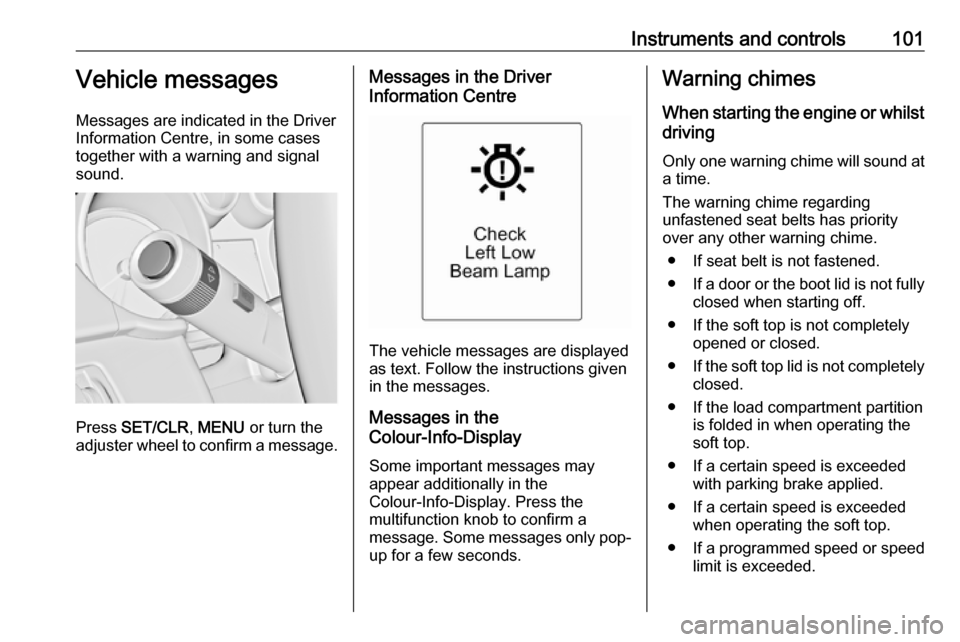Load compartment VAUXHALL CASCADA 2018.5 User Guide
[x] Cancel search | Manufacturer: VAUXHALL, Model Year: 2018.5, Model line: CASCADA, Model: VAUXHALL CASCADA 2018.5Pages: 265, PDF Size: 7.82 MB
Page 48 of 265

46Seats, restraintsHorizontal adjustment
Pull bolster of head restraint forwardsslowly. It engages in several
positions.
To return to its rearmost position, pull
fully forwards and release.
Head restraints on rear seats
Height adjustment
Pull the head restraint upwards and
let engage. To move downwards, press the catch to release and push
the head restraint downwards.
Removal of rear head restraint
E.g. when using a child restraint
system 3 63.
Press both catches, pull the head
restraint upwards and remove.
Place the head restraint in a net bag
and secure the underside of the bag
with the Velcro fasteners on the load
compartment floor. A suitable net bag
is available at your workshop.
Active head restraints
In the event of a rear-end impact, the front parts of the active head
restraints are moved slightly
forwards. Thus the head is supported
so that the risk of whiplash injury is
reduced.
Page 70 of 265

68StorageStorageStorage compartments................68
Glovebox ................................... 68
Cupholders ................................ 69
Front storage ............................. 69
Armrest storage .........................70
Centre console storage .............70
Load compartment .......................71
Rear storage .............................. 73
Rear floor storage cover ............73
Lashing eyes ............................. 74
Warning triangle ........................74
First aid kit ................................. 74
Loading information .....................75Storage compartments9Warning
Do not store heavy or sharp
objects in the storage
compartments. Otherwise, the
storage compartment lid could
open and vehicle occupants could be injured by objects being thrown
around in the event of hard
braking, a sudden change in
direction or an accident.
Glovebox
The glovebox features a pen holder,
a credit card holder, a coin holder and
an adapter for the locking wheel nuts.
Close glovebox whilst driving. It can
be locked with the vehicle key.
Page 73 of 265

Storage71Load compartment
Load compartment extension
Folding load compartment partition
To enlarge the load compartment when the soft top is closed, the load
compartment partition can be folded
in.
β Close soft top 3 34.
β Open the boot lid 3 24.
β To fold in, push the load
compartment partition at the looparea upwards to the inside.
β To fold out the load compartment
partition, pull the loop downwards to the rear. The pass-through flap
must be closed in vertical
position with the Velcro
fasteners.
During soft top operation or when it is opened, the load compartment
partition must be folded out.A warning chime sounds and a
message appears in the Driver
Information Centre if the load
compartment partition is not folded
out fully, including the pass-through
flap behind the rear seats, when operating the switch to open the softtop.
Folding rear backrests
To enlarge load compartment further
or to gain access to the wind deflector
bag, both rear backrests can be
folded down.
Page 74 of 265

72Storage9Warning
Take care when operating the
electric foldable rear seats. The seat backrest is folded with
considerable power. Risk of injury, particularly to children.
Ensure that nothing is attached to
the rear seats or located on the
seat cushion.
β Remove big wind deflector if installed 3 41.
β Press the catches and push down the head restraints 3 45.
β Pull the release switch p on one
or both sides of the load
compartment, to fold down the
backrests onto the seat cushion.
β To fold up, raise the backrest and
guide it into an upright position
until it engages audibly.Caution
When loading the vehicle from the passenger compartment, fold in
the load compartment partition.
Otherwise the load compartment
partition may be damaged.
9 Warning
When folding up, ensure that
backrests are securely locked in
position before driving. Failure to
do so may result in personal injury or damage to the load or vehicle in the event of hard braking or a
collision.
Pass-through flap behind rear seats
For transporting long objects in the
load compartment, a pass-through
flap between load compartment and
vehicle interior can be opened:
β Remove the installed big wind deflector or the bag with the
stowed wind deflectors behind
the rear seats 3 41.
β Close soft top 3 34.
β Push the load compartment partition at the loop area upwards
to the inside 3 71.
Page 75 of 265

Storage73
β Open the pass-through byswivelling the flap upwards to
horizontal position. The flap is
fixed in opened or closed position
with a Velcro fastener.
β Fold down rear backrests by pulling the release switches p in
the load compartment.
β To close the pass-through, swivel
the flap downwards and fix it in vertical position with the Velcro
fastener.
Fold out the load compartment
partition by pulling the loop
downwards to the rear, in order to
open the soft top. The pass-through
flap must be closed in vertical
position.
Rear storage
Hooks for carrier bags
Use the hooks at the upper edge of
the load compartment for hanging up carrier bags. Maximum load: 5 kg.
Rear floor storage cover
Rear floor cover
The rear floor cover can be lifted and
removed. Under the cover there is the
spare wheel, vehicle tools or the tyre
repair kit.
Page 76 of 265

74StorageLashing eyes
The lashing eyes are designed to
secure items against slippage, e.g.
using lashing straps or luggage net.
Warning triangle
Warning triangle is stowed in the
space on the inside of the boot lid
behind the straps.
First aid kit
The first aid kit is stowed on the right
side in the load compartment behind
a strap.
Page 77 of 265

Storage75Loading informationβ Heavy objects in the load compartment should be placed
as far forward as possible.
Ensure that the backrests are
securely engaged. If objects can
be stacked, heavier objects
should be placed at the bottom.
β Secure objects with lashing straps attached to the lashing
eyes 3 74.
β Use the hooks in the load compartment for hanging up
carrier bags 3 73. Maximum
load: 5 kg per hook.
β Secure loose objects in the load compartment to prevent themfrom sliding.
β When transporting objects in the load compartment, the backrestsof the rear seats must not be
angled forward.
β Do not place any objects on the instrument panel, and do not
cover the sensor on top of the
instrument panel.β The load must not obstruct the operation of the pedals, parking
brake and gear selector lever, or
hinder the freedom of movement of the driver. Do not place any
unsecured objects in the interior.
β Do not place any objects on the covers of the roll bars behind the
head restraints.
β Do not drive with an open load compartment.9Warning
Always ensure that the load in the
vehicle is securely stowed.
Otherwise objects can be thrown
around inside the vehicle and
cause personal injury or damage
to the load or vehicle.
β The payload is the difference between the permitted grossvehicle weight (see identification
plate 3 237) and the EC kerb
weight.
To calculate the payload, enter the data for your vehicle in the
weights table at the front of this
manual.
The EC kerb weight includes
weights for the driver (68 kg),
luggage (7 kg) and all fluids (fuel
tank 90% full).
Optional equipment and
accessories increase the kerb
weight.
Page 103 of 265

Instruments and controls101Vehicle messages
Messages are indicated in the Driver
Information Centre, in some cases
together with a warning and signal
sound.
Press SET/CLR , MENU or turn the
adjuster wheel to confirm a message.
Messages in the Driver
Information Centre
The vehicle messages are displayed
as text. Follow the instructions given
in the messages.
Messages in the
Colour-Info-Display
Some important messages may
appear additionally in the
Colour-Info-Display. Press the
multifunction knob to confirm a
message. Some messages only pop- up for a few seconds.
Warning chimes
When starting the engine or whilst
driving
Only one warning chime will sound at
a time.
The warning chime regarding
unfastened seat belts has priority
over any other warning chime.
β If seat belt is not fastened.
β If a door or the boot lid is not fully
closed when starting off.
β If the soft top is not completely opened or closed.
β If the soft top lid is not completely
closed.
β If the load compartment partition is folded in when operating the
soft top.
β If a certain speed is exceeded with parking brake applied.
β If a certain speed is exceeded when operating the soft top.
β If a programmed speed or speed
limit is exceeded.
Page 117 of 265

Lighting115If a headlight flash is activated when
the high beam is on, the high beam assist will be deactivated.
If a headlight flash is activated when the high beam is off, the high beam
assist will remain activated.
The latest setting of the high beam
assist will remain after the ignition is
switched on again.
Headlight flash To activate the headlight flash, pull
lever.Headlight range adjustment
Manual headlight range
adjustment
To adapt headlight range to the
vehicle load to prevent dazzling: turn
thumb wheel ? to required position.
0:front seats occupied1:all seats occupied2:all seats occupied and load
compartment laden3:driver's seat occupied and load
compartment laden.
Dynamic automatic headlight
levelling 3 116.
Headlights when driving
abroad
The asymmetrical headlight beam
extends visibility at the edge of the
road at the passenger side.
However, when driving in countries
where traffic drives on the opposite
side of the road, adjust the headlights to prevent dazzling of oncoming
traffic.
Vehicles with halogen headlight
system
The headlights do not have to be adjusted.
Page 144 of 265

142Driving and operatingEngine exhaust9Danger
Engine exhaust gases contain
poisonous carbon monoxide,
which is colourless and odourless and could be fatal if inhaled.
If exhaust gases enter the interior
of the vehicle, open the windows.
Have the cause of the fault
rectified by a workshop.
Avoid driving with an open load
compartment, otherwise exhaust
gases could enter the vehicle.
Exhaust filter
The exhaust filter is a particle filter for diesel and gasoline engines.
Automatic cleaning process
The exhaust filter system filters
harmful soot particles out of the
exhaust gases. The system includes
a self-cleaning function that runs
automatically during driving without
any notification. The filter is cleaned
by periodically burning off the soot
particles at high temperature. This
process takes place automatically
under set driving conditions and may
take up to 25 minutes. Typically it
needs between seven and twelve
minutes. Autostop is not available
and fuel consumption may be higher
during this period. The emission of
smells and smoke during this process is normal.
System requires cleaning
Under certain conditions, e.g. driving
short distances, the system cannot
clean itself automatically.
If cleaning of the filter is required and if previous driving conditions did not
enable automatic cleaning, it will be
indicated by illumination of % and a
warning message in the Driver Information Centre.% illuminates along with a warning
message when exhaust filter is full.
Start cleaning process as soon as
possible.
% flashes along with a warning
message when exhaust filter has
reached the maximum filling level.
Start cleaning process immediately to
avoid damage to the engine.
Activate self-cleaning process To activate cleaning process,
continue driving, keep engine speed
above 2000 rpm. Shift down if
necessary. Exhaust filter cleaning is
then started.
Cleaning process is completed more quickly at high engine speeds and
loads.
Control indicator % extinguishes as
soon as the self-cleaning operation is
complete. Keep on driving until self-
cleaning operation is complete.